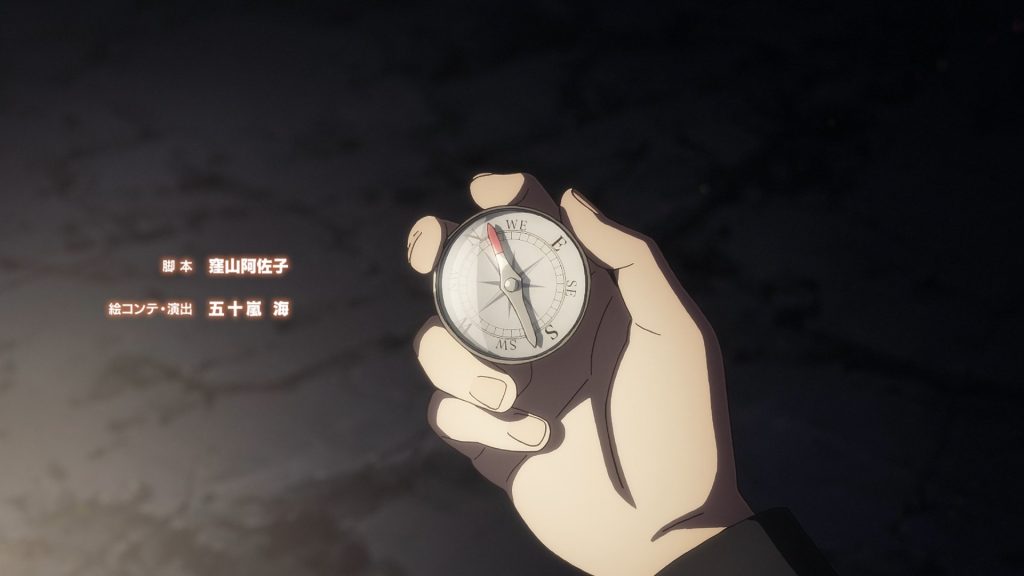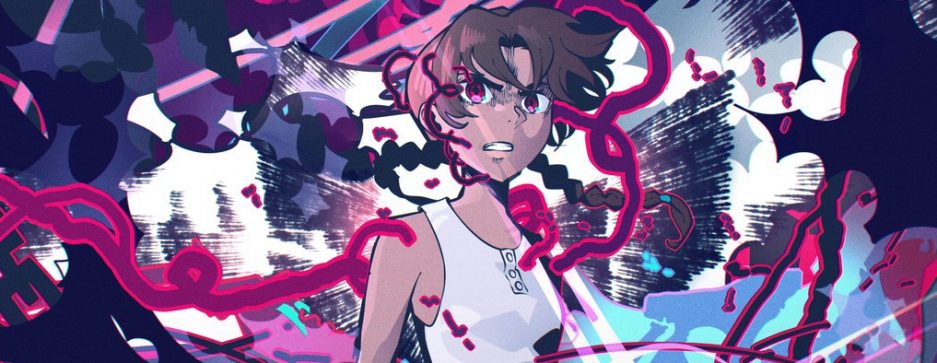Did you know Kai Ikarashi directed and storyboarded this episode?
It’s true. Here, I even took a picture of the credits.

That’s his name, right there: 五十嵐海.

It means Sea of Fifty Storms.
Goddamn that’s metal. Isn’t that the most metal name you’ve ever heard? It’s absolutely a 99.9th percentile name to me. Most names that try too hard to go hard go tryhard and suck, but this one doesn’t. This name has history.
The family name “Ikarashi” comes from the Ikarashi River in Niigata, which in turn was possibly taken into Yayoi-period Japanese from Yayoi-period Ainu as something like “Inkarasipe.” If true, the Ainu name could be rendered as something like “Fairview:” the most boring toponym to ever nym a topos. The Yamato court decided they could do better, and came up with the much more exciting “Fifty Storms” when figuring out how to write down Old Japanese names in their Old Chinese written records. They gave it a poetic etymology about the “five winds and ten rains” which bless the farmers of Niigata with good harvests. According to them, the legendary Emperor Suinin’s legendary eighth daughter, Ikatarashihiko no Mikoto, is the real source of the name. She’s credited with developing the area around the basin, and is even enshrined at the Ikarashi Shrine in Sanjo: a fascinating historical figure if only we knew she were real.
This information largely comes via Japanese Wikipedia from Hidezou Yamada’s 1993 Tohoku: An Ainu Toponym Study published by Soufuukan. The text regrettably isn’t available online, but appears to be peer reviewed. Archaeologist Tetsuo Kikuchi, writing for the Weekly Reader, admits that toponym etymology is something of a pursuit for hobbyists, but one – he insists – which Yamada undertook carefully and in dialog with the existing literature on human migrations in prehistoric Japan. Yamada finds that Ainu toponyms are about as common as Japonic ones north of a linguistic fault line traced roughly from Sendai to Akita through Yamagata, which lines up well with the tremendous mixture of Ainu and Yamato material cultures found in that region. You might well ask what an Ainu name is doing all the way in Niigata, which is something Yamada appears to have asked himself too, since he titled that section “Even as far south as Niigata?” He recognized that this is a bold claim which demands a hardy argument leveraging a substantial evidentiary base, and so, attentive reader, should you. However, I gather from a cursory glance at another paper citing Issue 94 of The International Journal on the Sociology of Languages that he is not the only one to suggest Ainu etymologies for some toponyms on Honshuu’s west coast.
At this point, I should caution that when I say “Ainu toponym,” I mean “toponym of Ainu etymology,” not “toponym which local Ainu speakers used.” Linguists should stop me if they’ve heard this one before, but it turns out that when the Tokugawa Bakufu went to catalog what the Ainu called various places, the locals sometimes just gave answers like “the middle island,” which were then recorded as proper names. “Inkarasipe” may be a Japanese toponym of Ainu etymology, but the Ainu speakers living there likely called the river something else – if they called it anything at all. As may be seen, toponyms are often tied to attempts to build an effective bureaucratic apparatus: an activity which is often incompatible with careful ethnography.
Kikuchi also somberly notes that these volumes were published posthumously; Yamada passed away shortly before their release. In many ways, this is the culmination of Yamada’s life work. Before the war, Yamada was a high ranking bureaucrat: buddies with wartime Prime Minister Hideki Toujo. His career took him through the Ministry of Agriculture, the Ministry of Commerce and Industry, the Department of Chemistry at the Ministry of Munitions, and ultimately ended at his wartime post as director of the Sendai Office of Mining. It was in Sendai that he first took notice of Touhoku’s toponyms – probably around the same time he first took notice of brutal forced labor in Sendai’s mines. It’s interesting that his final work would be so suggestive of a fundamentally multicultural, multiethnic origin of Japan as we know it. It seems Yamada thought so too.
Ultimately, it’s hard to say where exactly the name “Ikarashi” comes from. 五十嵐 is such a bizarre way of spelling out I-KA-RASHI even by nanori standards that it must reflect something, but unlike some rather fanciful kanji name spellings, there isn’t an obvious homophone in modern Japanese. Since I can’t evaluate Yamada’s argument myself, I can only conclude that it’s the more likely of the two explanations I’ve found, but I simply can’t accept it as the most likely possible explanation: there is simply too much we do not and cannot know. Instead, we can only guess at how such a cool name ever came into existence.
Anyway, Kai Ikarashi’s episode of Tengoku Daimakyou is pretty sick. Kou Yoshinari even stopped by to do some shockingly restrained animation by Kou Yoshinari standards – what was up with that? If I were a normie, I probably wouldn’t’ve even noticed something weird was going on except for that one last part where Maru and Kiruko are digital paintblobs. Then there was that dramatic running scene. Several of them, actually. Juuichi runs away from the commune. Kiruko runs at the Hiruko. Juuichi runs towards Juugo. Kiruko runs away with Juugo. That’s pretty Ikarashi-rashii, right? I too have seen SSSS.Gridman. That was a great cartoon too, huh?
Well, thanks for reading!
